
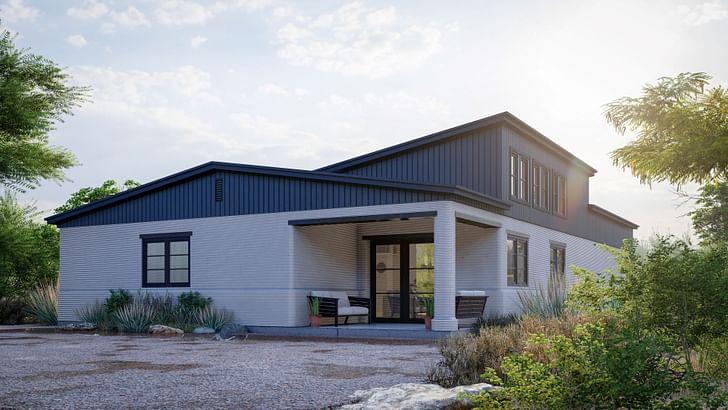
3D printing is older than you may think. The term was first coined in a 1984 patent, while the idea of generating 3D objects from 2D drawings dates back to sci-fi visions as early as 1945. Fast forward to today, and 3D printing has become a viable method of producing everything from medical stents to passenger vehicles. For those involved in building design and construction, the advent of 3D printing poses several questions: What is it like to design and build a 3D printed structure? How does an architect approach the process? What does the future hold for 3D printed architecture?
In this article, we seek answers to these questions by speaking with an architect who has gained real-world experience in delivering a 3D printed house as well as one of the world’s leading innovators in 3D printed construction.
For architecture and construction, sectors often lamented for poor metrics in affordability, innovation, and sustainability, the last decade has seen 3D printing grow from a niche preoccupation to an industry obsession. Archinect’s own coverage of the topic demonstrates how far the technology has traveled. In one of our earliest articles on 3D printed architecture in 2012, we carried a quote from Neri Oxman, who said “when people look at the ability to 3D print using a robotic arm, they’re very, very curious about the possibility of, in the future, printing full-scale houses.”
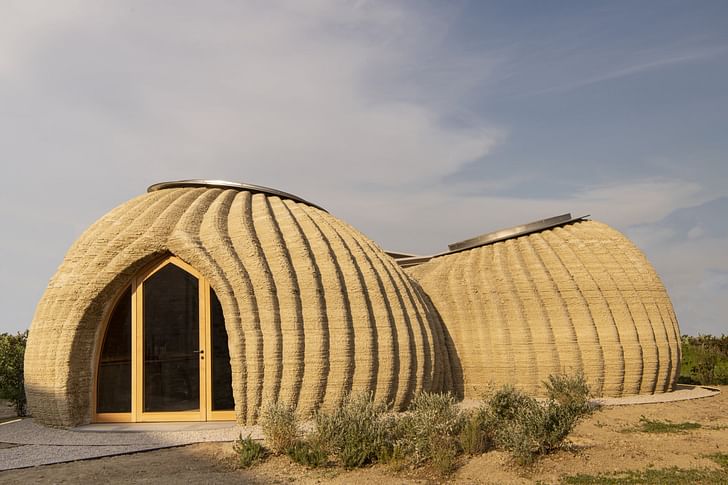
Nine years later, Oxman’s speculation has played out at an astounding pace. In 2021 alone, we have seen the construction of 3D printed raw earth houses, 3D printed floating houses, 3D printed schools, 3D printed footbridges, and even 3D printed Airbnb listings. The near future is even more ambitious, from a California development seeking to become the world’s first 3D printed net-zero neighborhood, to Bjarke Ingels Group’s plans to build a 3D printed district in Texas with 100 homes, and BIG’s designs for a 3D printed simulation habitat for life on Mars.
The future of 3D printed architecture will be not defined by our physical ability to produce such structures but by their commercial viability in real-world market conditions.
The ability for humans to create 3D printed buildings and infrastructure is clear. However, the future of 3D printed architecture will not be defined by our physical ability to produce such structures but by their commercial viability in actual market conditions. Exhibitions, tech institutes, and R+D facilities offer rich ground for speculation, but this output does not automatically translate into real-world adoption. Given her role at the MIT Media Lab, Oxman was equally aware of this, noting in her 2012 assessment: “I think specifically in the Media Matter Group, we don't focus only on efficiency translations. For that, I would open a practice in the commercial world, but that's not the function of this lab.”

The question on the lips of many architects is this: Will the market potential of 3D printing make it an unavoidable staple of construction, demanding the same intricate knowledge from architects that masonry, concrete, or timber construction systems do today? Or will 3D printing remain broadly in its current state: An exception to the rule of commercial and real-estate construction, exploited by a dedicated niche within the industry? In pursuit of an answer, there is merit in directing the media spotlight away from the mesmerizing projects listed above and instead speak to those with experience of delivering a 3D printed building for real-world, market-orientated use.
To do this, we must venture away from the labs of Cambridge, Massachusetts, and shift our focus onto the city of Tempe, Arizona. Here, Habitat for Humanity Central Arizona has used 3D printing to construct a residential project, seeking to understand the potential for 3D printing to deliver affordable housing across the country. The Tempe project is Habitat’s first 3D printed home in the United States, and the first too for Candelaria Design Associates, a custom architecture firm based in Scottsdale, Arizona, led by principal architect and founder Mark Candelaria. “As a firm specializing in bespoke, custom architecture, our background was not in production housing,” says Damon Wake, Candelaria’s project manager for the Habitat house. Speaking to us about the project, Wake describes both the challenges and practicalities of delivering a 3D printed house, one with little precedent but an abundance of determination on behalf of Habitat, Candelaria, 3D printer manufacturer PERI, local contractor Fortis, and a team of structural engineers.
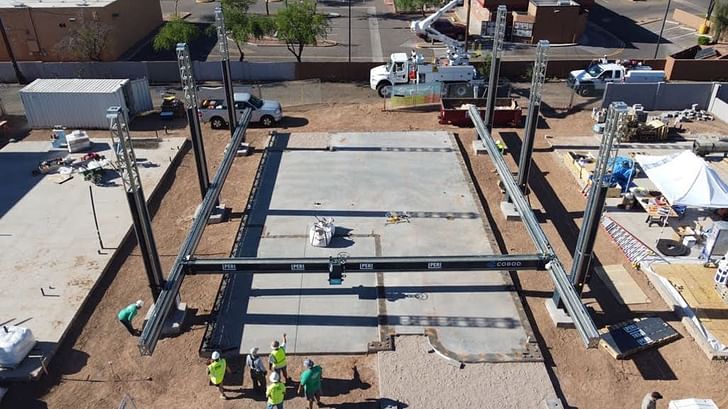
The process began in late 2019, when the client, architect, and delivery team set out to use 3D printing to deliver a cutting-edge home, and a blueprint for Habitat’s future operations in affordable housing. The decision to construct the home in Tempe was itself a consequence of the project’s unorthodox construction method. “We examined municipalities within the Phoenix metro area who would be willing to cooperate with us on the project,” Wake explains. “We were operating within a grey area of the ICC building code. While ICC does not contain specific guidance on 3D printing, it allows for ‘other’ types of construction subject to city approval, hence the need to find city officials willing to try new things. Some cities were not cooperative, but Tempe was. In fact, they were so excited by the project that they joined many of our weekly design calls, allowing us to sketch ideas in real time, and garner their feedback from early in the process.”
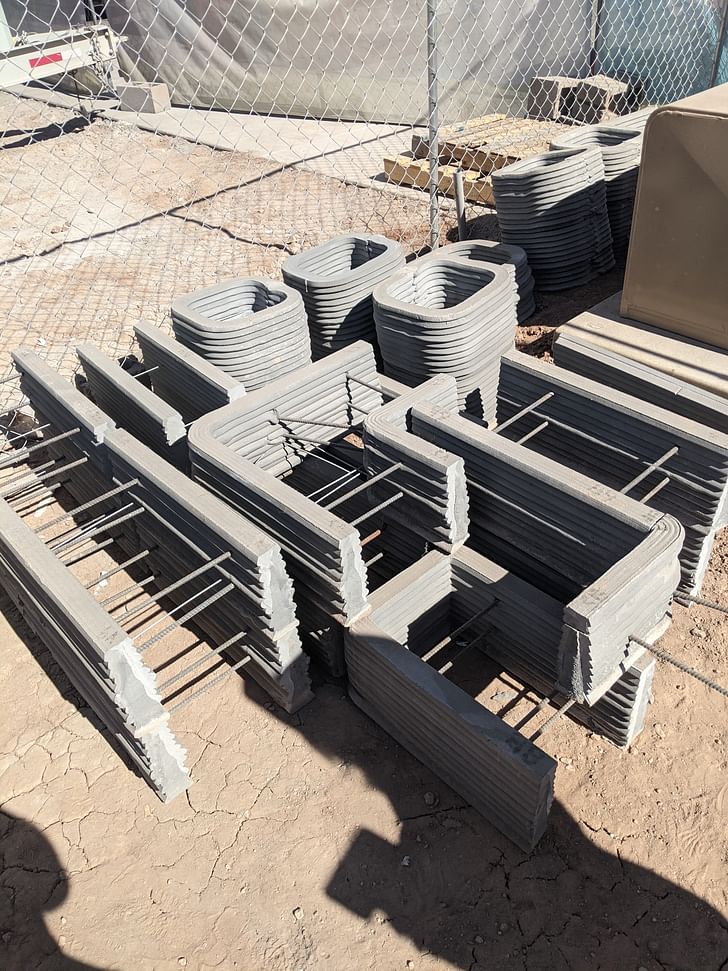
The team selected an urban infill site in Tempe which held pre-approval for a single-family home using a traditional construction method. An early challenge for Wake’s team was to adapt the design to be delivered using 3D printing, without compromising the general layout. “The layout plan largely stayed the same,” says Wake. “But beyond that, the schematics of delivering the project had to completely change.”
The layout plan largely stayed the same. But beyond that, the schematics of delivering the project had to completely change.
During the design stage, this ‘complete change’ was exemplified by the scale of collaboration between the architect, engineer, contractor, and print manufacturer. In a similar spirit to the early collaboration with city officials, the architects were required to engage with the engineering and delivery team far sooner than would be expected in a traditional project. “Normally, we engage engineers predominantly at detail or construction design stage, where the scheme has already moved past a fluid design process during concept and schematic design,” Wake explains. “This project was different. The engineering team, PERI, and Fortis, all provided early, granular feedback on the logistics of how the printer would operate, including how the printer would be set up, and how it would work on a detailed level.”
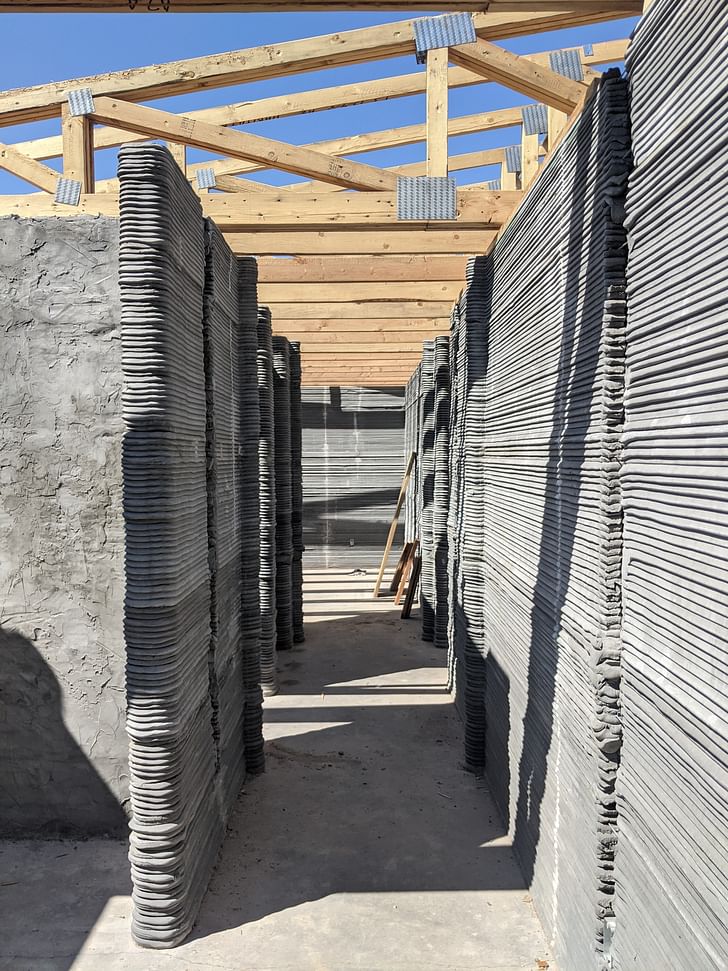
In contrast to traditional construction systems which are supported by decades or centuries of precedent, the team’s use of 3D printing required real-time learning and experimenting to carve a way forward. While PERI’s ongoing construction of a 3D printed house in Germany provided a degree of applicable knowledge, the design stage also involved transporting a 3D printer to nearby Phoenix, AZ, where components could be test-printed to inform the design process.
As the scheme moved from the drawing board and onto the construction site, the 3D printing process continued to confront Wake’s team with novel challenges.
With the design finalized, a fresh challenge arose of how to translate the certified design into a constructed scheme. “In normal circumstances, the architect completes the design, produces a PDF set of drawings, and prints the drawings on paper,” Wake explains. “Those printed drawings, and sometimes the supporting BIM model, become the contract document that the contractor builds from. However, for this project, in addition to our permitted drawings, we needed to convert the design to a file which could be read by the 3D printer.” In collaboration with PERI, Wake’s team used Fusion360 to convert their BIM file to a clean version to be fed into the 3D printer. For example, as the printer could not interpret sharp 90-degree angles, the team converted each right-angle corner to a radial arc. In addition, while traditional construction drawings often include thicknesses of wall build-ups, the print file required only a single centerline along the path of the wall to direct the printer head. Any time the wall featured an opening, such as a door or window, the centerline would stop, and continue on the other side of the opening.
“We spent a lot of time building the Fusion360 file devoid of BIM information,” Wake recalls. “The file became a series of planes stitched together. PERI then took that file and sliced it along horizontal layers, akin to layers in a lasagna. This series of layers could then generate the print file.”
As the scheme moved from the drawing board and onto the construction site, the 3D printing process continued to confront Wake’s team with novel challenges. One chief obstacle was the scheme’s ‘layer print time,’ essentially the length of time taken for the printer to complete one layer of a wall’s length before beginning the next layer on top. Crucially, the next layer must begin printing while the layer underneath is still wet, to allow the layers to bond. If the layer print time is too long, and the print layer has cured or dried before the next layer is added, the lack of adhesion between the layers will cause delaminating, cracking, and excessive movement, similar to constructing a masonry brick wall without mortar.
Estimating the print time is quite demanding and is something which almost all 3D printing projects in the future will have to contend with.
“Our original design called for a singular circuit of internal and external walls all printed at once,” Wake explains. “However, this created too long of a layer print time. We, therefore, had to break the walls into multiple prints, creating a gap between portions.” The decision of how to divide the project into printing segments was itself critical. While it may seem natural to take the overall wall length in the project and divide it along regular intervals, the team had to account for the varying speeds at which the printer could print in straight lines versus corners.
“The concept is similar to that of a race car,” Wake continues. “The car does not travel at a regular speed across a circuit; it speeds up in straight lines but spends a disproportionate amount of time navigating corners at slower speeds. The more turns and angles, the longer the print time.” This process is made even more complex when considering how much 3D printing material is emitted relative to the speed that the printer is traveling. “Estimating the print time is quite demanding and is something which almost all 3D printing projects in the future will have to contend with,” Wake advises. “The layer print time will even change depending on the climate and time of day. With our project, set in the hot Arizona summer, we had to ensure the concrete did not dry more rapidly than it would do in colder climates, for example.”
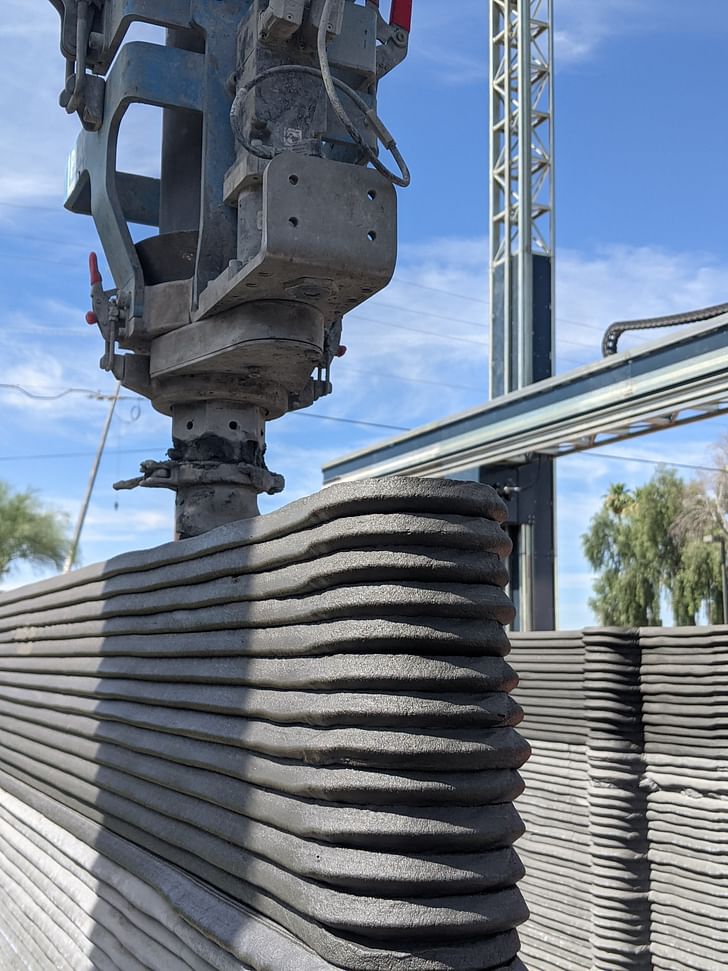
Although all walls within the Habitat project were 3D printed, Wake’s experience has led him to believe this isn’t necessarily the most effective approach. The external envelope saw two 3D printed concrete walls printed side-by-side, separated by a cavity layer with insulation to meet energy codes. Similar to traditional construction, the cavity allowed for the installation of services such as wiring and plumbing, with a masonry knife used on the internal leaf to manually create desired service openings, and even to add control joints to accommodate expansion and contraction in the wall. However, for internal partition walls, the decision to 3D print the walls left no cavity within which to install services, in contrast to cavities found within steel and timber stud walls. As a result, the team had to carefully consider and commit to the placement of fixtures such as electrical outlets from before construction even began.
There’s very little in the way of a '3D printing guide to construction.' It required a lot of figuring out.
“In the future, we would not 3D print internal walls,” Wake concludes. “In a traditional project, you have decades of industry knowledge, and thousands of components which the industry has developed, specifically geared towards integrating with a specific workflow. You have millions of people with years of experience working within the parameters of that workflow. With 3D printing, we had none of this. Everyone had to figure out every minor detail, reflect on it, test it, and implement it. There’s very little in the way of a ‘3D printing guide to construction.’ It required a lot of figuring out.”
This ‘figuring out’ filtered through to design challenges often considered second nature in traditional projects, such as installing wall cabinets. While manufacturers of wall-mounted cabinets require a smooth wall finish to install their product, the cake-layer finish of the internal walls in the Habitat house required further treatment to allow for such installation. For Wake, this high level of interconnectedness within the industry forms a significant barrier which 3D printing must overcome. “The conclusion we arrived at is that if you are not constructing a cavity or insulation in the wall, it remains far cheaper, quicker, and easier to construct walls with timber,” Wake says. “The time which you may theoretically save on printing internal walls has to be balanced against the ease at which finishes and furniture can be added to that system. In some ways, this is similar to traditional construction: the method for creating internal walls doesn’t necessarily have to match that of the external walls.”
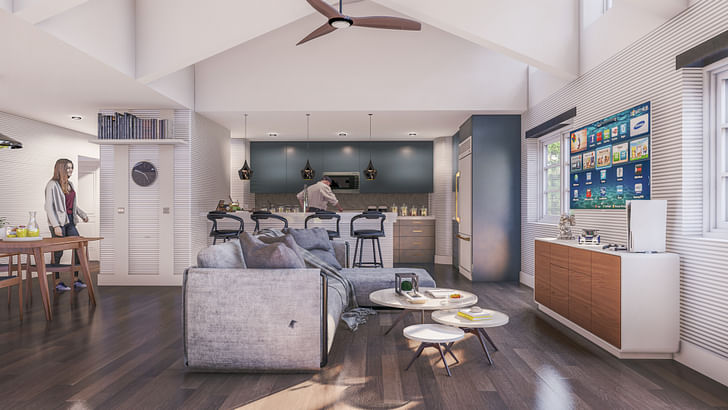
Among the many novel challenges which Wake encountered during the Habitat project, perhaps the most unexpected obstacle was found not in print files or cure times but in building code. “Building code does not currently recognize 3D printed walls as a primary structural system,” Wake explains. “Therefore, we needed to add another system in addition to the 3D printed walls, which comprised of glulam beams running horizontally above the walls, connecting via steel plates to a series of reinforced concrete columns hidden within the 3D printed walls, which run down to the foundation.”
Architects in the U.S. can only use 3D printed systems as enclosures, and not as a primary structure.
“This is not a system we would repeat,” Wake continues. “However, because building code does not allow for the use of un-reinforced concrete walls for structural purposes, we had no choice but to build the secondary structural system. You can’t reinforce 3D printed concrete. If you erected a steel reinforcing bar, the printer head would simply hit it. And adding the steel reinforcement after the print is impossible given how quickly the material cures.” As a result, architects in the U.S. can only use 3D printed systems as enclosures, and not as a primary structure, an anomaly that Wake says even surprises professionals within the industry. There are signs however that this may be a short-lived issue. Wake notes that ICC has engaged with the design team for the Habitat home to further understand the particulars of 3D printed construction, signaling a potential future upgrading of building code standards to facilitate 3D printed projects.

As early adopters of 3D printing for real-world construction, Wake’s team found themselves in a relentless process of solving instantaneous problems with little precedent. However, despite the intricacies and considerations listed above, Wake sees a promising future for the technology in the construction industry in certain circumstances.
It was a difficult experience, but a positive one.
“It was a difficult experience, but a positive one,” Wake reflects. “Further down the line, I see at least two useful applications for the technology which are not hindered by its weaknesses. It may prove useful in industrial and agricultural architecture, which do not require a high level of integration or interdependence with other subtrades, and instead focus on the delivery of shells such as barns and warehouses. In addition, 3D printing has demonstrated an ability to construct curvilinear elements far more cost-effectively than concrete or masonry. For projects with hyperbolic elements, such as pavilions or feature walls in homes, 3D printing has clear potential.”
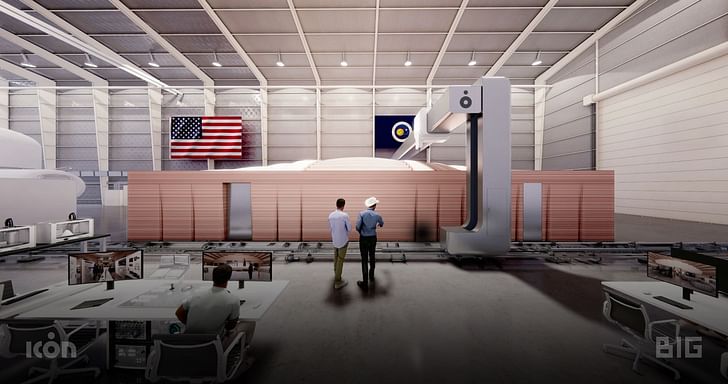
While Wake does not ascribe to a near future which sees row upon row of 3D printed mass housing, 3D printing innovators ICON hold a more optimistic outlook. Recognized as industry leaders in 3D printed construction, the company’s portfolio includes completed 3D printed multifamily homes with Logan Architecture, and futuristic collaborations with Bjarke Ingels Group ranging from NASA habitats on Mars to 100-home residential neighborhoods in Austin, Texas.
For ICON CEO Jason Ballard, 3D printing will form a central pillar for the future delivery of affordable housing. “Over the last 25 years, the construction industry has lost productivity. There is also a severe skilled labor shortage that is only going to get worse,” Ballard told Archinect. “In general, the process of homebuilding is inefficient and wasteful. The global housing crisis is a problem at scale and thus the solution will need to be at scale. Homes of all sizes and types. We believe 3D printing is the toolkit of the builder of the future. 3D printing is a profoundly better way to deliver housing. It is faster, cheaper, offers more design freedom, offers higher speed, scalability, sustainability and resiliency.”
We believe 3D printing is the toolkit of the builder of the future.
To achieve their goal of creating resilient, sustainable homes, ICON has adopted the use of a cementitious material named Lavacrete, which offers more durability and thermal efficiency than typical construction materials. “The 3D printed wall system in our homes provides thermal mass that slows heat transfer into the home,” says Melodie Yashar, ICON’s Director of Building Design and Building Performance. “The combination of thermal mass, increased insulation, and an airtight wall increases the energy efficiency of our homes and reduces lifecycle costs. The material also provides safer, more resilient homes that are designed to withstand fire, flood, wind, and other natural disasters as compared with stick-frame construction, as an example.”

Looking further to the future, the company is striving to make 3D printing a go-to construction solution in an increasingly automated industry. “Increased digitization and automation is certainly the goal for the future,” says Yashar. “Currently, we are 3D printing the wall system of ICON homes, but in the future, we will aim to move beyond this to automate as many processes as possible. Long term, our vision is to scale this technology globally. Numerous projects are underway to deliver social housing, disaster relief housing, and market-rate housing in addition to developing construction systems to create infrastructure and habitats on the Moon and eventually Mars with NASA.”
Meanwhile, while Wake sees a future for 3D printing in the construction industry, his experience leads him to see the technology in a similar light as other innovations which currently capture the public imagination. “Decades ago, we imagined that by 2020, roads would be dominated by autonomous cars,” Wake explains. “While the technology now exists, even in certain real-world conditions, we are continually discovering the pragmatic complexities of real-world application. It takes time, energy, investment, and people. I do not believe we will see rows of entirely 3D printed suburban streets tomorrow, just as I don’t expect to see rows of exclusively autonomous cars. However, the opportunity is there in the future.”
With every new technology, you are adding one more tool to your kit of options.
As the Habitat house nears its completion in Tempe, Arizona, Wake’s experience on the project has resulted in an optimistic but balanced view for the future of 3D printed architecture. “With every new technology, you are adding one more tool to your kit of options,” Wake explains. “As an architect, you approach a project initially with a plethora of options. However, as you consider the specific needs of a site, client, and function, you narrow down your applicable tools based on design, cost, feasibility, and ultimately find the right one.”
“I believe 3D printing will be one of the tools that designers can choose from but will not always be the easiest, the cheapest, or the best for every single scenario. It will find its niche.”
Niall Patrick Walsh is an architect and journalist, living in Belfast, Ireland. He writes feature articles for Archinect and leads the Archinect In-Depth series. He is also a licensed architect in the UK and Ireland, having previously worked at BDP, one of the largest design + ...
6 Comments
with crazy weather in our future I think factory built parts put together in the field has more of a future, houses or small bridges that come in 6 pieces. Built real tight in the factory, inspected and then bolted together in the field. The 3D printing might best become a big part of that rather then the center.
that is already widely used everywhere, buildings come in blocks of bedrooms or living areas with all fixtures and windows, field assembled and finish roofs and exteriors. But 3d printing doesn't work in field prep., utilities, footings, foundation walls, landscaping and grading, etc.
There was a small bridge recently published printed in some alloy in Amsterdam; I agree with you, as it is with cars and large appliances, 3d printed automation could be applied to building parts, nobody has made the jump yet.
does that mean my grandkids will wage their real estate bidding wars in 2080 on en vogue, pre-pandemic suburbs with 'original wood framing'?
i think it's going to take substantial development in construction-specific printers before this becomes generally useful. maybe at that point there will be self-mobile robotic tools which would make 3D printing unnecessary.
robot workers would be infinitely useful and genuinely transformative. 3d printing seems like a solution in search of a problem.
No
I have seen videos where they reinforce the walls with steel pieces that are put on layer by layer. I imagine in the future that printers will look more like an octopus or stacked able to print multiple points at once and able to add in other materials with robotic arms.
Block this user
Are you sure you want to block this user and hide all related comments throughout the site?
Archinect
This is your first comment on Archinect. Your comment will be visible once approved.